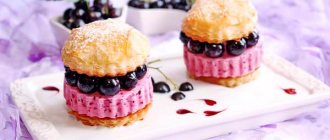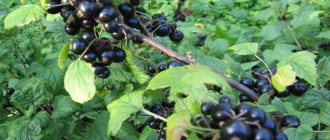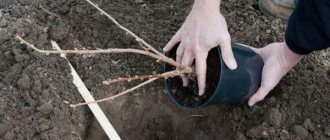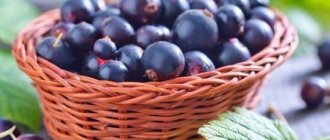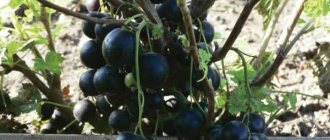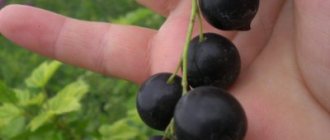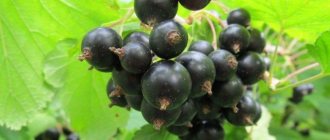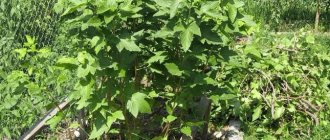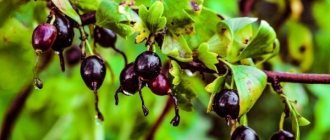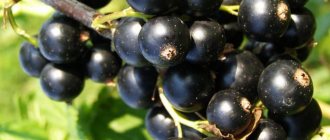Black currant Summer resident is the choice of many gardeners for cultivation in their garden plots. It does not require much care, withstands cold, resists major diseases and produces a harvest of large berries.
Black currant "Dachnitsa"
“Dachnitsa” currant is large-fruited, the weight of one berry can reach up to 5g
the taste of “Dachnitsa” berries is incredibly sweet, with no sourness
Brief history of the variety
Black currant Dachnitsa was bred at the All-Russian Research Institute of Fruit Crop Breeding and the Siberian Horticulture Research Institute by crossing varieties with similar characteristics - Seedling Golubki and Bredtorp.
Breeders - Z. Zotova, T. Ogoltsova, L. Bayanova and S. Knyazev. The new hybrid was included in the State Register in 2004.
The crop is intended for cultivation in temperate climates in the North-Western and Volga-Vyatka regions. Resistant to cold temperatures down to -30 degrees. The fruits ripen early. The bush is compact, the berries have a sweet taste.
It is not advisable to grow summer black currant in southern climates due to sensitivity to heat and poor tolerance to drought.
Appearance of the Summer Resident
Black currant is a perennial plant. Characterized by its small size compared to other varieties.
Bush
Compressed spherical shape, low. It reaches a height of 1.2 m. The branches are not densely located, there are gaps. The main direction of growth is straight and upward.
Young stems are lush green, with a shimmer. In an adult plant, the main branches are rigid and woody. They darken to a gray-brown color and the ebb decreases.
Roots
The root system is fibrous and strong. Placed at a depth of 35-42 cm. The central rod is deepened up to 1 m into the ground. The remaining roots intensively grow 45-50 cm wide from the center of the bush in the horizontal direction.
Currant roots do not produce offspring.
Leaves
The leaves are medium in size, located on low petioles. The structure is five-bladed, corrugated. The leaves are soft to the touch.
Each blade is separated by deep longitudinal recesses of a burgundy hue. The color of the leaves is green with a slight bronze tint.
Flowers
Collected in clusters of up to 12 pieces. Almost all of them produce an ovary. Medium size with a delicate light brown color.
The plant is self-pollinating, but to obtain larger fruits, it is recommended to plant other varieties of black currant nearby.
Berries
The fruits of this variety are considered large. Weight ranges from 3 to 5 g.
Also characteristic of berries:
- spherical shape, slightly elongated;
- peel color is bluish-dark;
- the skin is loose and tender;
- small seeds are contained in small quantities;
- the pulp is sweet and soft;
- slightly sour taste;
- the aroma is pronounced;
- sugar content - 9.5%, vitamin C - 195 ml/100 g; This amount satisfies the body’s daily needs.
Ripe fruits hold tightly to the stalk for a long time and do not fall off.
Collected fruits are better preserved at low temperatures and do not lose their original taste and beneficial properties.
Description
The bush of this type of currant is low, has a medium spreading crown with medium density, green, shiny and completely hairless shoots. When its branches become woody, they acquire a light gray-brown tint. Basically, the bushes of the Dachnitsa variety have a regular, rounded shape.
This black currant has fairly large fruits, the weight of each berry varies between 2 grams or a little more. The thin, delicate skin is dark blue, almost black. The berries have a pronounced aroma, delicate taste and are perfect for eating or making jam and preserves, but it is almost impossible to store them. The fruits are used for sauerkraut, and the leaves are used in pickles and marinades.
The crop is medium-yielding; it reaches peak fruiting at the age of 5-8 years. In this case, it seems possible to collect up to 1.5 kilograms of berries from one bush or up to 9 tons from 1 hectare of plantings of this currant variety. Summer resident is considered an early ripening blackcurrant. It has thick, strong shoots, on which light green buds appear.
a brief description of
| View | black |
| 4,6 / 5 | |
| 2-3 g | |
| 9 t/ha |
| Term | early |
| 4,2 / 5 | |
| -32°С | |
| strong |
The plant is resistant to frost, does not suffer from powdery mildew and bud mites. If the flowering time falls during spring frosts, you need to smoke it.
Advantages and disadvantages
Fruit ripening time is the 3rd year after planting. The bush bears fruit from mid-June. During the harvest season it bears berries at regular intervals. One bush produces up to 1.5 kg of berries.
On farms on an area of 1 hectare, up to 8 tons of crops are harvested per season. Most currants can be collected when the plant is between 5 and 8 years old.
This variety grows best in temperate climates, for which it was specially bred. The root system is adapted to cold temperatures down to -30 and does not require additional insulation.
The summer resident does not tolerate the southern climate well: plant growth slows down, the size of the bush decreases, and it produces little yield. Sensitive to dry soil and excessive exposure to sunlight. Needs constant additional watering and the creation of artificial shade.
This variety is chosen because of its many advantages:
- large fruits and high yield;
- early ripening of berries;
- self-pollination;
- rich taste and high vitamin C content;
- resistance to pests and major diseases;
- adaptability to cold weather;
- berries are intended for universal use;
- currants retain their taste and nutritional properties for a long time;
- the fruits are well transported.
Currants have their disadvantages:
- fallen fruits quickly deteriorate;
- flowers wither from frost;
- the branches are not strong enough, they bend towards the ground under the weight of ripening berries;
- needs pruning;
- the ground near the bush should be free of weeds and fallen leaves;
- the plant does not tolerate dry periods well, especially in the first 2 years;
- does not grow well in warm climates.
In case of sudden frosts, during currant flowering, it is worth steaming the bushes to preserve the flowers.
Characteristics of the variety
During the hybridization of the berry crop, the currant variety “Dachnitsa” inherited resistance to low temperatures from the starting varieties. The fruit bush rarely gets sick and is practically not affected by garden pests. Bears fruit consistently. Black currants are suitable for growing in the country and large farm plots.
Drought resistance, frost resistance
A zoned variety of blackcurrant was created. The culture is adapted to low temperatures. Without insulation of the root system, it can withstand frosts down to -350 C. If the temperature drops below, the roots of the “Dachnitsa” variety must be mulched. The shrub poorly restores frozen parts of the root system, which negatively affects fruiting. The drought resistance of black currant "Dachnitsa" is low. Without watering, the berries become small, the plant stops growing and may die.
Productivity and fruiting
The first fruiting occurs in the third year of the bush's growing season. According to reviews, the peak yield of the currant variety “Dachnitsa” occurs at the age of five. Then the crop degenerates, the berries become smaller, the fruiting rate drops, it is recommended to replace the black currants with young ones.
An early variety, the berries ripen simultaneously by mid-June. The bush produces about 2.5 kg of fruit per 1 sq. m, two bushes are placed, the harvest is approximately 5 kg. The berries are large, glucose predominates in the composition, taste without acid. If the crop is grown in the recommended regions, the berries are not baked in the sun.
Area of application of fruits
Black currant berries have a universal purpose. The variety is suitable for cultivation on a large scale for the food industry. At home, the fruits are used to make compote, jam, preserves. Currants retain their biological composition when fresh berries are ground with sugar. Safely retains taste and presentation after freezing. The fruits last a long time after picking and tolerate transportation well.
Resistance to diseases and pests
Among the priority tasks for the originators was the development of a variety with good immunity against fungal, viral, and bacterial infections (powdery mildew, anthracosis, rust). There are parasitic insects: moth, gall aphid, glass beetle. The crop's resistance to infection is high and its resistance to pests is average.
Advantages and disadvantages of the variety
The zoned crop has the only drawback: rapid aging and degeneration of varietal merits. According to reviews, black currant “Dachnitsa” differs from other varieties in a number of advantages:
- large-fruited, with excellent gastronomic rating;
- berries ripen early and evenly;
- self-fertile, there is no need to plant other varieties of currants nearby;
- frost-resistant, adapted to temperate climates;
- unpretentious in care;
- compact, not spreading;
- berries of universal use;
- has good immunity to infections;
- It is stored for a long time and transported safely.
Attention! Black currant “Dachnitsa” will meet all the criteria if it is cultivated in the regions declared by the originators.
Preparing for landing
To plant black currant Summer Resident, gardeners select the right place and prepare the soil.
Landing season
The time for planting seedlings is mid or late September, depending on climate and weather conditions. During the autumn period, the plant takes root in the soil, and winter freezing of the root system does not occur.
Planting in early spring is allowed, but the currants may not have time to take root sufficiently for full growth and future fruiting.
Site selection
Black currant Summer resident grows well and bears fruit if the territory meets the requirements:
- located in open space on the south side of the site;
- The landing area is flat and spacious;
- High humidity and close proximity to groundwater are not allowed;
- soil with natural drainage to prevent the root system from rotting;
- absence of drafts and cold winds;
- Most of the area should be well lit, slight darkening is allowed.
Excess sun slows down plant growth and dries out the soil.
Before planting, special attention is paid to soil composition and acidity. The plant develops well in loamy or chernozem soil with weak acidity 6.0-6.5 pH.
Plant currants in loose soil rich in nutrients. If there is a shortage of them, organic fertilizer - compost or humus - is first applied. It is not advisable to use ready-made fertilizers with an abundance of minerals.
If bushes from the Gooseberry family previously grew in this place, the soil has accumulated toxic substances and become significantly impoverished. Plant growth and development will slow down.
Planting material
You need to buy young seedlings that are two years old: the plant is already strong and the root system has grown. This bush takes root well, quickly and can withstand temperature changes.
When choosing a seedling, pay attention to:
- Root system: should not be broken and have dry shoots. Color - brown-rusty. The number of main shoots is 2-4, length 15-20 cm. Numerous small and thin roots of a lighter shade extend from them. The dark brown color of the root indicates improper storage and ill health of the plant: it was exposed to frost, was overdried or diseased.
- Aboveground part: consists of 2-3 shoots 35-45 cm long. The color of the branches is even light brown, the surface is smooth with soft buds. For planting in early spring, select seedlings with young foliage.
Immediately before planting in the ground, currants are prepared. The root is dipped in a nutritious and growth-stimulating solution.
Soaking time: keep a healthy and undamaged plant for about an hour; with dried, frozen and injured roots, the time increases to 3-5 days.
Tillage
Young black currant Summer Resident is planted in prepared soil:
- the site is dug up to the depth of a shovel;
- weed away weeds and remains of dry grass and branches;
- insufficiently moistened soil is watered 2-3 days before planting;
- depleted soil is saturated with organic fertilizers.
Landing rules
For a full growing season and productive fruiting, it is recommended to follow the rules of agricultural technology for this variety. They fertilize and plant healthy seedlings at a certain time. Select a site with the soil composition necessary for currants.
Recommended timing
Currant "Dachnitsa" is placed on the site in the spring, when the soil has completely warmed up (around the beginning of May) or in the fall, so that there are three weeks left before the onset of frost. This time is enough for the root system to adapt to a new location. Work is carried out in the first half of September. It is necessary to focus on the characteristics of the climate.
Choosing a suitable location
For normal plant development, the variety is planted on slightly acidic, fertile soil. To prevent root rot, the soil must be well drained. An area with close groundwater is not suitable for black currants. In the lowlands, the bush will not give the desired harvest. In an elevated place, excess ultraviolet radiation has a detrimental effect on vegetation. Frequent watering and shading on a hot sunny day are necessary. The best option is the south side behind the wall of the building.
Selection and preparation of planting material
The quality of the selected planting material determines the timing of fruiting and the plant’s resistance to infection. A seedling is selected according to the following parameters:
- a well-developed root system should not have damage or dry areas;
- the bush should have two or three stems with smooth light brown bark;
- presence of viable fruit buds.
For spring propagation, blackcurrant seedlings are selected with foliage. In autumn, planting material is obtained by dividing the bush after shedding its leaves. Before placing on the site, the root is dipped in a solution that stimulates growth for 5 hours.
Landing algorithm
Prepare a soil mixture from the following components:
- turf soil and compost (in equal parts);
- 150 g potassium sulfate;
- 150g phosphate;
- 2 kg of ash.
Sequence of work:
- Make a recess of 40 cm, diameter - 55 cm.
- Pour in the prepared planting mixture.
- Place the seedling vertically and distribute the roots along the bottom of the hole.
- Cover with soil, taking into account that the root collar should be above the surface (6 cm). The soil is compacted and moistened abundantly.
- Trim the top part to two fruit buds.
- The root circle is mulched with organic matter or peat.
Proper planting of black currant Summer resident
Maintaining the distance between the bushes and step-by-step work when planting a seedling guarantees good rooting and rapid growth.
Sequencing:
- The young plant is planted in a hole: the depth and diameter are half a meter. If there are several bushes, then the distance between the holes is 1.5-2 m. This distance does not create darkness between adult bushes.
- The hole is filled 2/3 full with excavated soil mixed with fertilizers. For fertilizer per 1 sq. m will need:
- compost or humus - 15 kg;
- potassium chloride - 65-75 g;
- superphosphate - 120-140 g;
- wood ash - up to 2 kg.
- The seedling is lowered into the hole in a straight position, the roots are carefully placed without displacing small shoots to one side.
- The hole with the plant is filled with the excavated soil and the soil is compacted so that it does not sag too much when watering.
- Irrigate generously with 2-2.5 buckets of water.
- Mulch to retain moisture.
- The branches are trimmed so that a shoot of up to 15 cm and 2-3 buds remain on it.
Fertilizing is useful for rooting the plant and creating a reserve of nutrients. In the spring, during active growth, fertilized soil ensures full growth and development of the bush.
Currant care
Black currant summer resident needs constant care: loosening the soil, removing weeds and watering. Due to its small size, the bush is not fixed to a support.
Find out how to care for currant bushes in autumn here. And also read our other article on how to properly care for currants in the spring.
With proper care, currants bear berries for more than 12 years.
Watering frequency
The currant bush requires moderate but constant watering. Make a small depression 30 cm wide near the tree trunk and pour water into this area.
The roots are located at a depth of up to 40 cm and when watering you need to wet the layer of soil to this distance. An adult plant requires 2 buckets of water for proper irrigation, a young plant - 1.
Watering frequency: 1 time per week. In the summer, irrigation is increased up to 2 times; in the evening, the leaves are sprayed.
Additional moisture requirements occur during flowering and fruit set, during harvest, and before winter.
It should be taken into account that lack of moisture leads to:
- deterioration of the taste of berries and their crushing;
- reduction in yield;
- poor tolerance of winter cold.
Trimming technology
The currant bush must be cut through, getting rid of unnecessary branches.
This is required for:
- formation of the correct plant shape;
- the formation of gaps between the branches for access to sunlight and air - this is how the berries, under the influence of ultraviolet radiation, ripen to a large size;
- directing the flow of nutrients to fruiting branches;
- stimulating the growth of new shoots;
- getting rid of old branches on which little ovary is formed;
- removing diseased and damaged parts of the bush.
Time spending:
- Early spring, when the currants have not yet awakened from wintering and the movement of juices has not begun. Learn about spring pruning of currants from this article.
- Late autumn, after the movement of nutrients has completed. We recommend reading the article on how to properly prune currants in the fall.
Basic rules for pruning:
- Begins in the first year at the time of planting. The branches are shortened, leaving 2-3 buds on each. The shoots form the main skeleton of the bush.
- In the 2nd year, these branches are cut off and the buds are left for the growth of young shoots.
- On the 3rd and 4th, 3-6 of the strongest ones are left from the new ones, the rest are cut off. The tops of last year's shoots are shortened.
- By the 5th or 6th year, the shape of the bush is fully formed. Now they only carry out preventive pruning: they get rid of old, diseased and damaged branches.
Every year 3-5 new main shoots are left, last year's branches are shortened so that 3-4 buds remain on them.
Periodic cutting of old branches promotes constant renewal of the plant and stable yields. It is better to lubricate the cutting area with garden varnish.
After winter, in order to prevent diseases, frozen and rotten branches are cut off. At the end of autumn, the bush is rid of old and dried branches.
Soil care
Currant Summer resident is demanding on the condition of the soil. To ensure good growth conditions you need:
- get rid of weeds, fallen leaves and branches;
- periodically loosen the soil, providing oxygen and moisture to the roots;
- To prevent the soil from drying out, mulch it, especially in early summer.
Introduction of fertilizing
To accelerate the growth of the currant bush and increase productivity, fertilizing is applied several times a year:
- In spring - organic matter or ammonium nitrate: dissolve 50 g in water and pour under each bush. For plants older than 5 years, 2 times less feeding is required. About spring feeding is written here.
- In autumn - in October, use organic fertilizer: compost, bird droppings or a ladle of ash. How and with what to fertilize currants in the autumn, read here.
Mulching
The soil is mulched before winter to preserve the root system. Use: dry leaves, sawdust, pine needles, peat or humus.
The thickness of the layer depends on the climatic conditions of the growing region.
Frost protection
When the temperature drops below -30 degrees. and constant temperature changes, additional protection from frost is built for an adult currant bush and newly planted seedlings. In addition to mulching, the bush is covered with cardboard or wrapped in cellophane.
Aftercare
According to reviews from gardeners, “Dachnitsa” currants do not require special agricultural technology. Caring for the variety includes the following activities:
- In the first year of the growing season, black currants are fed with organic matter and ammonium nitrate at the time of foliage formation; in subsequent years, fertilizers are applied twice: before flowering, phosphate or urea, and at the time of fruiting, potassium.
- Pruning is carried out in the fall, old branches are removed, young shoots are cut from above, approximately to the top two buds. In the spring, frozen areas are cut off.
- Black currant “Dachnitsa” is not tolerant to soil drying out; moistening should be moderate but systematic. Before the onset of frost, watering is increased.
- The plant is compact, short in stature, and does not require fixation to a support.
Although the “Dachnitsa” variety is frost-resistant, to avoid the risk of freezing of the root system, mulching is carried out with sawdust, dry leaves or pine needles. In winters with little snow, cover the bush with spruce branches or polyethylene. To protect against rodents, special toxic agents are placed between the currants.
Harvesting
Fruiting begins in the 3rd year after planting, and the peak occurs after the 5th year. The harvest is harvested in several approaches.
Store in a refrigeration unit in plastic containers; the berries do not crack when defrosted. Shelf life in the freezer is up to a year.
The summer resident tolerates transportation well.
Currants are used to prepare:
- preserves, compotes and jams;
- sweets and pastilles;
- medicinal infusions.
When crushed and mixed with sugar, it retains all the beneficial substances.
Shelter for the winter
The summer resident tolerates seasonal cold snaps well, but requires preparation for the winter season. Agronomists recommend covering shrubs for the winter in two cases:
- when planting in a cold region;
- if the currant is less than 3 years old.
Otherwise, before wintering, the bush is pruned, the soil is fed with complex fertilizer and a 3-5 cm layer of mulch is laid on the ground: sawdust, hay, humus, grass. When growing currants in Siberia and the Urals, as well as young crops, the bush is covered before the onset of a sharp cold snap with any windproof material - spanboard, agrofibre. The shelter is removed no earlier than the beginning of March, and then pruning is carried out.
On a note! It is not recommended to cover currants with plastic wrap; it does not allow air to pass through, which increases the risk of mold or mildew.
Reproduction
The summer resident is propagated in several ways.
Cuttings
It is a young shoot 20 cm long cut off from the mother bush. It is separated in the fall with an oblique cut. Placed in the ground in an inclined position. There should be 2-3 buds on the surface of the trunk. Over the winter the cutting takes root and in the spring it is planted in the ground.
Rooting cuttings
A two-year branch is selected from a large three-year bush with good yield.
Procedure:
- taken to the side, bent and rooted in the soil;
- cut off the top and fix the stem with wooden staples;
- sprinkle with earth and water.
The cuttings are connected to the mother bush, it receives nutrition and quickly produces roots.
Removal time is early spring before the leaves appear. By autumn, the root system will grow and 2-3 new shoots will appear. The cuttings are separated from the bush and planted in a permanent place.
Breeding is the most common and convenient way to propagate a currant bush.
Dividing the bush
Produced in autumn. A one-year-old plant is dug up and divided into parts. The independent part of the bush must have roots and a solid trunk. The branch is trimmed, leaving 20-25 cm. The young bush is planted in the prepared hole and watered.
How to care for a summer resident
The Summer Resident variety needs the same care as other varieties with minor differences.
Trimming. Since the bushes are small and not dense, formative pruning is done only in the fifth year, leaving the best shoots. To do this, thickening is eliminated, diseased branches are removed, young shoots are pinched, and old shoots are shortened to four buds. If old branches are periodically removed, giving way to young ones, then the plant will bear fruit for 15 years.
Click on the image to see it in full
Watering. It must be taken into account that currant roots are short and located close to the surface, and currants love moisture. Therefore, it must be watered during flowering and ovary, ripening of berries and in the fall. If the year is dry, 18-20 liters of water are poured onto the bush once every seven days. To do this, make small grooves around the bush so as not to catch the roots.
Diseases and parasites: methods of control and prevention
Black currant Summer resident is a crop that is resistant to major diseases and pests. A preventative examination of the bush helps to notice the first signs of the disease in the early stages.
Main diseases and pests:
- Moth caterpillar. It feeds on berries. For prevention, the site is dug up in the fall. Control method: spray the leaves with shag solution in the spring.
- Glassware. It lives on branches and infects them. Control method: cut off the affected stems and treat the plant with karbofos.
- Aphid. Affects leaves. Control method: treat with special preparations or a soap solution with ash, excluding the flowering period.
- Rust. The bush is covered with dark spots. Method of control and prevention: pruning the affected parts of the bush, spraying with a one percent solution of Bordeaux mixture. Eliminate flowering and harvest time.
Read more about currant diseases and pests here.
Disease prevention:
- choosing a suitable landing site;
- cutting off affected areas;
- after winter, before the soil completely thaws, water the bushes and soil with hot water;
- periodic spraying with Bordeaux mixture;
- before the flowering period - treatment with tobacco tincture.
Diseases and pests
Currants of the Dachnitsa variety have enviable resistance to powdery mildew, as well as bud mites, but this does not significantly shorten the list of those who want to dine at your expense. A universal protective measure is to water the shrubs with boiling water in early spring, pouring copious amounts of boiling water onto the soil under the plants.
currants do not suffer; all kinds of pests are not ready for high temperatures. The easiest way to water a bush with boiling water is to use a regular garden watering can.
In the event that, despite resistance to the bud mite , the pest is still detected (some buds are too large), before flowering and after flowering, the plants must be sprayed with Neoron, Actellik, Akarin, to choose from. Processing should be carried out strictly according to the instructions.
When examining a bush with already growing fruits, caterpillars were noticed that had settled in the still green berry. This is a moth, more precisely, its caterpillar and measures to combat it should be preventive in nature - digging up the soil under the bushes in the autumn and spraying with shag infusion before flowering.
The currant bushes are well-groomed, strong, pleasing to the eyes, but then some strange shoots appeared, crooked, weak with small leaves? It was the currant glass that snuck onto your site and settled in the shoots.
Currant Dacha has been pleasing gardeners for more than ten years since its appearance; the variety has shown all its advantages and has spread far beyond the borders of Siberia - the place where it was obtained and its popularity is growing every year.
Gardeners about currants Summer resident
★★★★★
Natalya, 39 years old, Kirov. I planted the Summer Resident 4 years ago.
It was accepted well, I learned to trim it myself. She never got sick. I collect large and tasty berries, make jam from them and simply sugar them. The bush overwinters well, although I try to mulch it to protect it from frost. I am very pleased with the currants. ★★★★★
Nikolay, 61 years old, Cheboksary. I planted 4 currant bushes at once in the fall.
It has been growing for six years now. I took it right away. Mastered annual pruning. It's not difficult to do. I constantly pick berries in the summer: some have been picked, others are ripe. I treat my grandchildren. I'm going to plant a few more bushes. ★★★★★
Antonina, 53 years old, Nizhny Novgorod. I only have 1 bush growing.
I planted it last year. This year I have already harvested. I really liked the berries. So big and delicious! The bush tolerates winter well and is easy to care for. I'm going to expand my garden with more currants. Hide
Add your review
Black currant Summer resident is a hybrid specially bred to grow in temperate climates. With proper care, the variety produces stable and large-fruited harvests. Easily propagated. The plant is resistant to pests. The berries are stored for a long time at low temperatures and are well transported.
0
0
Copy link
Description of the variety Dachnitsa
Summer resident - black currant for the June harvest. Its berries are large, sweet, very tender, with an unobtrusive aroma and thin matte skin - a wonderful dessert. It is practically devoid of acids, which distinguishes it from most other varieties.
The bush is simply a sight to behold - low, without thickening and as if with specially thinned foliage, it is dotted with beautiful black berries. For a small bush, a yield of four to five kilograms is simply fabulous.
Fruiting is stable and occurs in the third year after planting. The berries are harvested in several stages, which makes it possible to consume fresh currants until mid-season varieties begin to ripen. The self-fertility of the variety is good and increases when pollinated with neighboring currant bushes of other varieties.
